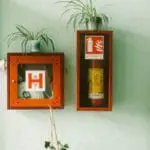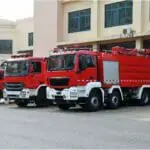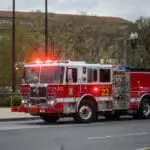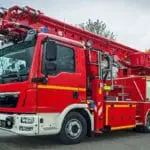You never know when you might need a fire extinguisher in your truck or car, so it’s always better to carry one, and to be sure you can rely on it.
That’s harder than it sounds though, as “vehicle fire extinguishers” is a market awash with unsatisfying products that can’ be relied upon when the need arises.
We tested out some of the best vehicle fire extinguishers on the market and lined them up for you – so you don’t have to do the testing we did.
Our top choice was the Buckeye 13315 2.5-pound extinguisher.
How Did We Choose?
Don’t listen to the rumors – size is important. For a vehicle fire extinguisher, we needed one that we could carry easily in our car or truck, so it had to be on the smaller side.
Ultimately, we decided something in the area of 14 inches in length, carrying 2.5 pounds of extinguishing substance was ideal. At that size, the extinguisher can fit under a seat, or be safely stowed in the trunk.
We also decided that any extinguisher on our list should have a metal valve and pin. Why? Because there’s a long history of plastic valve and pin extinguishers either going “phut” in a time of crisis or snapping altogether when used.
And finally, we made our decisions based on the availability of an easy-to-read pressure gauge. One of the last things you need when you have to use a fire extinguisher is the uncertainty over whether it still has any charge left in it.
A visible pressure gauge takes that worry out of the moment, and as such, it’s a thing we want in any vehicle fire extinguisher we use.
Three criteria. Easy, right? Thousands to choose from, you’d think?
Welcome to Wrongsville, have a nice day.
It was surprisingly difficult to get a vehicle fire extinguisher that met all our criteria. But we got there five times, so we can lay out our best finds for you.
The best fire extinguishers we found for trucks and cars are:
OUR TOP PICK
Wins our top prize for its aluminum pin and discharge mechanism that is reliable when it’s needed.
We’re not exactly easy to please, because when it comes to vehicle fire extinguishers, we believe in being tough, so that you know we’re not fobbing you off with inferior products.
So, when we tell you that the Buckeye 13315 feels like the best of the bunch all round, you know it has done the job we asked of it.
This is a sturdy extinguisher, with high-quality metal parts, meaning it will work reliably, whether you have it in your car for two days or two years before you need to use it.
There’s a clearly color-coded pressure gauge for easy reading in an emergency, and it comes with its own vehicle mount, so it won’t go rattling around if you stow it in the trunk (potentially damaging both the extinguisher and the trunk!).
We were aiming to find a collection of 2.5-pound extinguishers, and the Buckeye worked out to be the best fit for a range of vehicles.
When storing this extinguisher, you’ll need around 15 inches by about 5 inches of accessible space, which should be reasonably easy to find on most cars or trucks of even relatively recent design.
You can mount it in the trunk for ease, or alternatively, put it behind a seat for ease of access within the cabin of your car or truck.
It has a discharge range of 9-15 feet, which is useful for stepping away from the fire itself, and the discharge time is around 9 seconds if used continuously.
With an Underwriters Laboratory (UL) rating of 1-A:10-B:C, the Buckeye is effective on both liquid fires and electrical fires – two of the most likely fires you’ll encounter in a truck or car.
It’s also certified to withstand up to 120 degrees of heat during storage, which might seem excessive, but if you’re keeping it in the trunk of your car all through the summer, it’s a handy thing to know.
Pros
- A convenient fit – at 15x5 inches, this extinguisher can easily be mounted in a car or truck
- Aluminum pins and valves mean it will work consistently when needed
- Independently certified for A, B and C Class fires. Most car fires are B and C class (liquid and electrical fires).
- Comes with its own mount, so you don’t have to buy additional equipment
- A 9-15 feet discharge range means you can step away from the immediate area of danger and still put out the fire
Cons
- The 120 degrees of heat certification might not be adequate in a Southern summer
EDITORS CHOICE
The easy valve and pin system on the First Alert AUTO 5 give you a reassuringly fast discharge.
The First Alert Auto5 extinguisher surprises by quite how light it is – but it’s a happy surprise, because that lightness makes it easily portable.
But once you’ve got over the lightness, you find yourself drawn to the simple pin and trigger system here. It’s almost like the fire extinguisher equivalent of a BB gun – except of course it works like a full-on deadly serious extinguisher when you need it to.
In size, it’s even slightly smaller than the Buckeye, at 14.1 inches by 4.5 inches, so you’d think it would be easy to stow or mount. However, the supplied mount could well mean you need to dig out your drill to make holes in your trunk to fit it.
Unlike any other extinguisher we tried, the First Alert comes with a 10-year warranty, which is pretty much unheard-of in the market. But before you rush out and buy one, it’s worth understanding something else.
The extinguishing substance in the First Alert is sodium bicarbonate BC chemical. That means it only has a BC rating, rather than an ABC rating, like the Buckeye.
Why does that matter? Didn’t we just say that the most frequent fires you’re likely to encounter in a truck or car are within the BC range? Liquid and electrical, right?
Wellllll, generally, yes. But there’s a degree to which this depends on how new your car or truck is.
In older cars and trucks, if you pop the hood, what will stare back at you will be mostly made of metal. In that case, a BC rated extinguisher is just fine and dandy.
Pop the hood on a more modern vehicle though and you might be surprised to learn how much of its guts are based on plastics, which in turn are based on petroleum.
Try using a BC fire extinguisher on those and you get absolutely nowhere – whereas an ABC extinguisher will be effective in fighting any fires in those parts.
So, while it’s light and strong and effective, it’s worth noting that this is an extinguisher of most use in older, more mechanical vehicles, rather than more modern, precision-engineered ones.
It’s also worth checking with your local jurisdiction whether BC extinguishers are still considered acceptable for car and truck use where you live.
Pros
- This lightweight extinguisher is easy to swing into action
- The pin mechanism here is extremely simple to operate
- The action is on a par with the Buckeye, but it’s much more affordable
- The easy-to-read pressure gauge is highly convenient
- A small unit that comes with its own mount, measuring just 14.1 inches x 4.5 inches
- 10-year warranty means you have a degree of peace of mind when buying this extinguisher
Cons
- The mount may well need you to drill holes in your trunk
- This extinguisher only has a BC rating, meaning it’s not ideal for more modern vehicles
BEST VALUE
This smart extinguisher uses a clean agent called Halotron, which minimizes the damage to your car.
This is a very different fire extinguisher than you might be expecting. Its big deal is that it uses a substance called Halotron. While that sounds like an angelic transforming robot, it’s actually a clever product of necessary developments.
Back in the day that was the 90s, Halon 1211 was a common substance found in fire extinguishers, and it worked spectacularly well.
Unfortunately, it also worked spectacularly well at carving a hole in the ozone layer of the Earth. A rethink was necessary, and a switch was made to the dry chemical known as monoammonium.
This was fine as far as it went, but it had a tendency to be corrosive. So while it worked as a stop-gap, the aviation industry demanded a better solution that wouldn’t eat so much of its airplanes when used.
Halotron is that solution. It’s a relatively clean fire extinguishing agent specifically designed to be non-corrosive.
So, great – problem solved, right?
Well, yes and no. Problem solved for the aviation industry, sure. Do you have your own jet plane?
We’re asking because Halotron fire extinguishers for the everyday market tend to be priced towards the luxury car, sport car end of the market, and if that’s not what you have – and can afford to run – you might have to think twice before investing in a Halotron fire extinguisher for your vehicle.
Also – and this becomes annoying when you factor in the cost – Halotron fire extinguishers are legendarily less effective than other extinguishers, pound for pound.
You need 11 pounds of Halotron extinguishing agent to deliver the same fire suppressant power as just 2.5 pounds of ABC dry chemical and get your extinguisher a 1-A:10-B:C UL rating.
Which is why this edition only gets a 1BC rating – somewhat undoing the good work of having a non-corrosive extinguisher by losing it’s “A” rating.
That said, if you have a vehicle where corrosion would do it almost as much damage as the original fire, H3R is undoubtedly a premium player in the Halotron market.
It also goes an extra mile or two on presentation, eschewing the semi-traditional red for its extinguishers and going with chrome for that extra touch of bling.
Sizewise, it’s the smallest extinguisher we’ve seen so far too, coming in at just 10 inches high, by 3.6 wide, so fitting it in your car or truck will be absolutely no problem.
Just possibly losing it would be – but if you can’t immediately spot it, look for the shiniest thing in the cabin or trunk.
Pros
- Specially designed to be non-corrosive, and gentler on your car or truck’s materials
- It’s also the only extinguisher so far that is specifically designed to be used in cars, rather than being an adaptation of a wall extinguisher
- The chrome finish adds a stylish dimension to your extinguisher game
Cons
- Has no “A” rating, so it’s more suited to older metal vehicles
- Halotron extinguishers are only rated as ‘good’ against Class B and C fires, where dry chemical substances are ‘very good’
- The price point on this extinguisher makes those without premium vehicles and the cash to run them wince
RUNNER UP
If you run a Jeep or a truck with roll bars, this could be your extinguisher of choice. The mount supplied has been designed specifically with roll bars in mind.
Let there be no beating around the bush – Amerex comes to the fire extinguisher party with a great reputation behind it.
That being the case, while it’s not surprising to find two Amerex extinguishers in our top 5, it is surprising to find them both so low down the running.
Passing muster as an ABC extinguisher, the B417T is certified for both liquid and electrical fires and is suitable for use on any vintage of vehicle, including modern microchip-run engines.
You get a little longer discharge time on this model – a full 10 seconds, though it still only gives you the standard and 2.5 pounds of extinguishing substance.
While it’s outside our remit here, it’s worth noting that the B417T has also won praise for its effectiveness on boats and boat fires.
Not that that will necessarily be of use to you, but if you happen to have a boat hitched on behind your truck, it’s worth remembering to take the extinguisher with you when you hop offshore.
A larger extinguisher than many on our list, coming at 15.5 inches by 5.75 inches, you might find the B417T a tricky fit behind your seat.
But the good thing is that Amerex here is aiming specifically at owners of Jeeps and trucks with roll bars, because the harness included with the extinguisher is designed specifically to attach to those roll bars.
While it’s great to have lots of multi-option extinguishers on the market, we’re not going to lie – it feels good to know that a company makes an extinguisher that’s aimed squarely at truck and Jeep drivers.
That said, the specificity of the offering is one reason the Amerex B417T gets pushed down our list, inasmuch as it’s most useful to truck and Jeep drivers.
By definition, that means it’s a little too big and unwieldy for those with smaller cars to use on a regular basis, simply because they won’t have the intended place to stow it.
Trying to mount it behind a seat will be clunky and awkward in smaller cars, and because it’s slightly outsize, you may have trouble finding a trunk harness for it.
That means you have to be sure of your roll bar status before definitely going for this extinguisher – but if you have them, it’ll be one of the better offerings for you.
Pros
- Designed specifically to be carried on the roll bars of a Jeep or truck, this is a neatly niche fire extinguisher for particular classes of vehicle which are sometimes overlooked
- The extinguisher is usually sold with a bracket that helps attach it to the roll bars
- The easy-to-read pressure gauge means you’ll always know what to expect when you operate the extinguisher
- Amerex is beyond a shadow of doubt one of the leading brands in the fire safety market. That means you can buy with a degree of certainty and confidence
Cons
- The size of this extinguisher is awkward – it’s longer than most extinguishers on our list, at 15.5 inches. That means it may well be outsized for some smaller vehicles5. Victory 2.5 Lbs Extinguisher with Vehicle Bracket
RUNNER UP
It’s Halotron, but by Amerex, which is an appealing combination.
We stick with Amerex for the last extinguisher on our list – another Halotron version in case you like the idea, but want to stick with a familiar brand.
Like the H3R Halotron extinguisher, this model from Amerex is only rated for B and C class fires – liquid and electrical fires. That means it’s mostly suited for older, more mechanical vehicles.
But it also brings the benefits of Halotron, meaning it will be kinder on the metal of your car’s surfaces than some of the more corrosive and damaging dry powder extinguishers.
With a strong aluminum valve and all-metal construction, not to mention the Amerex name behind it, you can trust the B385TS extinguisher to work when you need it – which always has to be criterion #1 of any fire extinguisher.
Weighing in at a full 7 pounds, the B385TS is surprisingly heavy compared to the Buckeye at just 2.2. pounds.
And perhaps annoyingly for drivers of smaller cars, this model, like its predecessor, measures the full 15.5 inches in height, and is even wider in the base, at 6.38 inches.
That means it would ordinarily be an awkward extinguisher to mount, but thankfully it comes with its own vehicle bracket to at least take some of the sting out of that element.
Also like the H3R, you’re going to pay a lot more for the Halotron factor in this extinguisher than you will for its equivalent dry powder version.
That’s a fact that’s still galling when you consider the Halotron options are only B and C rated. But again, if you want to go the non-corrosive route, they are the best options on the market today.
The Amerex B385TS is a good example of the type of extinguisher that is popular among drivers with more expensive cars, but where H3R trades on quality of presentation and a certain bling factor, Amerex trades more or less on being Amerex, the company’s reputation racing ahead of it to announce that its extinguishers will always worth when they’re needed.
That makes it worth taking a serious look at. Whether the combination of the BC rating and the extra cost is worth it to you and your vehicle is for you to decide.
Pros
- The Amerex reputation proclaims the trustworthiness of this extinguisher
- Halotron extinguishers are more kind to the metal in high-value vehicles
- An aluminum valve should work whenever it’s needed
- Comes with its own mounting bracket
Cons
- Price – Halotron extinguishers are always going to be more expensive than dry powder equivalents
- Only effective on B and C class fires
- Oversize – as tall as the powder Amerex on our list, but broader at the base
Truck And Car Fire Extinguishers – A Buyer’s Guide: Everything You Should Be Looking For
When buying a fire extinguisher for your truck or car, consider: weight and size, certification, the range of fire classes it will fight, its length of discharge time, whether it has a metal valve and pin, whether it comes with a vehicle mount, DOT approval, and any warranty that comes with the extinguisher.
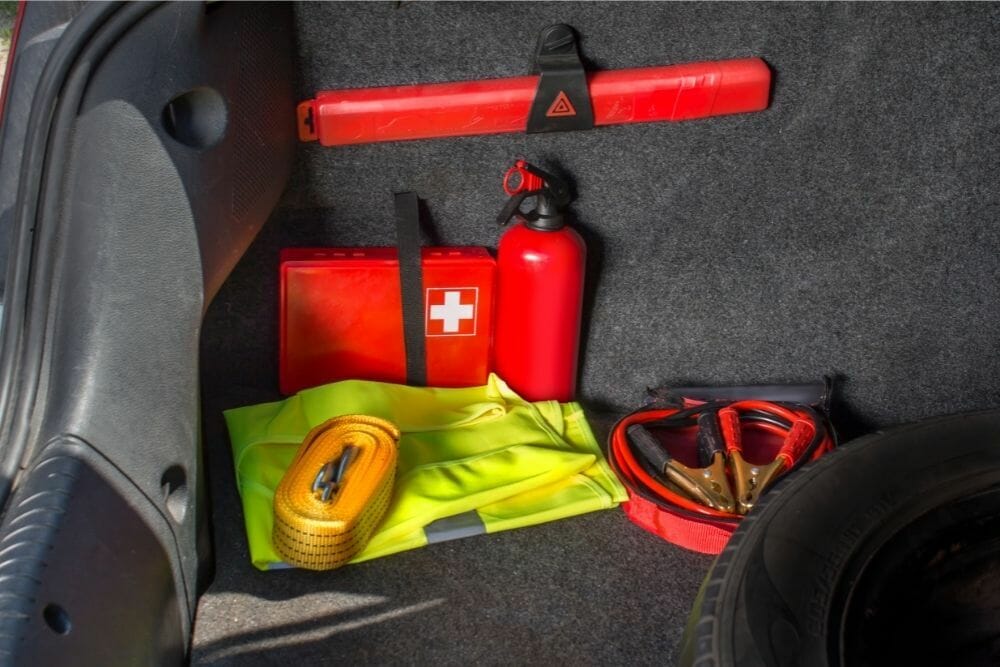
Weight
There are three main sizes of fire extinguisher – the 10-pound, 5-pound, and 2.5-pound versions.
If you’re in a big garage or workshop, you’re going to need to have the 10-pounder hanging on your wall, to deal with any larger or more complex fires that may be a regular part of the working environment.
They’re extremely reassuring, but be aware – they’re heavy to work with too, so under no circumstances take them for granted.
For kitchen safety, keep a 5-pound extinguisher handy. They’re not too heavy, but can give you the length of discharge time you need (usually around the 20-second mark) that you might well need to bring a kitchen fire under control.
We did think about using a 5-pound extinguisher as our go-to model for cars and trucks, but it’s just a little heavy and clunky to cart around.
That leaves the 2.5-pound model as our travel extinguisher. Small enough to mount behind a seat or in the trunk, you’re usually looking at something between 14–15 inches long and 5 inches wide for a decent 2.5-pound extinguisher.
Firefighting Certification
The Underwriters Laboratory (UL) is an independent assessment and certification company used worldwide as a benchmark for assessing the quality of products in respect of one another. Many states require any fire extinguisher sold to have a UL certification.
UL certifications grade fire extinguishers with a number and letter symbol such as 5-B:C. 5-B:C. Don’t worry about the code. It just means that the extinguisher can handle Class B and C fires and can cover a 5 square foot fire - when used by a trained firefighter.
UL certifications also frequently test an extinguisher’s resilience to heat and cold in storage.
often also test an extinguisher against hot and cold conditions while in storage, so people who buy them can know how to safely store them over time. Many of the extinguishers here were rated for storage in up to 120 degrees F.
Fire Rating
Most car and truck fire extinguishers are classed as ABC extinguishers. That means they can be used against three ‘classes’ of fire.
Class A fires are fueled by everyday combustibles – wood fires, paper fires, and for the purposes of car and truck use, plastic fires come under this category.
Class B fires are fueled by liquids and gases. Both gasoline and any of several motor oils would be in this category, which makes Class B a mainstay of extinguisher action.
Class C fires are fueled by electrically charged material. If you have a battery fire, that’s a Class C fire – again, Class C is a critical element of performance for most car and truck extinguishers.
Some jurisdictions require a car and truck extinguisher to have a full ABC rating – which is important to know before you spend a lot of money on one of the two Halotron extinguishers in our list, as they only have a BC rating.
Length Of Discharge Time
There’s a simple ratio here – the larger the extinguisher, the longer the discharge time. Most 2.5-pound extinguishers will give you a discharge time of around 9-10 seconds.
That gives you 9-10 seconds of continuous use to put out the fire. Obviously, if the fire defeats the extinguisher’s efforts in that time, get away from the vehicle and call the fire department.
Metal Valve And Pin Components
If your extinguisher has a plastic valve, pin, or discharge mechanisms, we wouldn’t recommend relying on it in a time of crisis.
Metal components have a much higher track record of effectiveness and performance in moments of high stress, so we would always recommend making sure your extinguisher has metal parts.
Mounting
Call us old-fashioned if you like, but when we buy a fire extinguisher for the car or truck, we want it to come with a mount, so that we’re not hunting for an aftermarket part before we can drive safely.
This can be particularly important, if for instance the fire extinguisher is meant especially for a particular type or class of vehicle (like a truck), or if it is of a particularly inconvenient size – too large and clunky to mount behind a seat, for instance.
Either way, buying a fire extinguisher for your truck or car is a whole lot easier if the manufacturer supplies a mount with which to attach it.
Be aware, your problems may not be over when the mount arrives. Some may involve drilling dubious holes into parts of your trunk.
If you’re not confident in your abilities to get this done right, by all means, get a professional to help you. You want it to be right, so you’re not plagued by rattling in the future.
Extinguishing Material
Most of the ABC-rated extinguishers you’ll find are filled with monoammonium phosphate, a dry chemical powder. The H3R and Amerex B385TS extinguishers use an alternative called Halotron, which is non-corrosive, but slightly less effective as an extinguisher than the dry power variants.
That also means the Halotron extinguishers only have BC ratings – again, it’s worth keeping this in mind, depending on the rules in your jurisdiction.
Is Your Extinguisher Rechargeable?
This is a very yin-yang thing. You can get extinguishers in either rechargeable or disposable models.
On the one hand, rechargeable extinguishers are kept and refilled, fire after fire (we assume for the purposes of sleeping at night that you don’t have too many fires in your car or truck).
But they can be painful to recharge, simply because companies offering recharging services may not be in every town. Similarly, sometimes local fire departments will be able to recharge your extinguisher. Annnd sometimes, they won’t.
Disposable extinguishers are thrown out once they’ve been used – which is quick and convenient, but will get you dirty looks from any polar bear you happen to meet as the planet – somewhat ironically, all things considered, burns to the ground.
Warranty
Most fire extinguishers – like most consumer products in the 21st-century, come with a warranty. But take a look at how long the warranty runs for.
If you can find a 10-year warranty, elevate that extinguisher on your list, because the manufacturer is prepared to back its product for the whole natural life of the extinguisher.
If you have an extinguisher older than 10 years, get rid of it, it’s probably useless and possibly against local extinguisher carrying regulations.
Causes Of Familiar Car Fires
Headline: electrical and wiring faults, oil and fluid leaks, car accidents, poor maintenance, and overheating are all common causes of car fires.
Electrical And Wiring Faults
If you’ve ever heard the term “hotwiring,” you should know that wires in your car or truck can cause sparks if they’re loose, frayed, or not where they should be. Add that to some flammable fluid and you have yourself a carferno.
Watch out for old wiring, poor or frankly pasta-like re-wiring, or any blown fuses, and get them sorted out as soon as possible.
Oil And Fluid Leaks
Put it this way – Fluids leaking out of you when you don’t expect them – not good. The same is true of your car or truck. Oil leaks, gasoline leaks, brake fluid leaks, transmission fluid leaks. You name it, it could create fiery havoc in your car.
You can get yourself an oil leak from any cracked engine parts, from caps not being correctly secured, or from simply overfilling.
Car Accidents
These are simply never good. In themselves, they’re a potential nightmare, but also, they can cause things that were never meant to touch to be pushed together – electrical wires and fuel oil, for instance.
What’s the advice on this? Simple – drive safely, and hope with all your heart that other people do too.
Maintenance Failure
A marriage, a dog, and a car are all only as good as the maintenance you put in. Poor servicing can lead your car to be a timebomb on wheels, if your wiring is shoddily maintained, for instance. Use a local, professional mechanic and get a certificate of work done every time.
Overheating
Overheating is a pretty simple issue – if your cooling system fails, the engine gets hotter. The cooling system though is pretty complex, with many points of potential failure – lines, pumps, coolant reserves, etc.
Keep an eye on your temperature gauge. If it starts to scream, pull over immediately and keep your extinguisher at hand while the engine cools down.
Preventing Car Fires
We’ve listed some of the most common causes of car fires. But knowledge of causes is useless if you don’t also have knowledge of prevention.
1. Drive Responsibly: We know this is an old saw, but the best way to prevent a lot of issues – especially accidents – is to drive safely and avoid everything else on the road.
2. Regular Servicing: Regular check-ups with your doctor and dentist keep you in peak condition, right? Same deal with your car – regular servicing by a qualified mechanic and electrician can help head off potential fire hazards before they happen.
3. Leaks: Oil like, fluid leaks, you name it – they’re a big red flag for fire hazards. If there’s fluid where you’re not supposed to have fluid, get it checked immediately.
4. Dry Grass: here’s one that won’t have occurred to you. Don’t park over long, dry grass. The undercarriage of your car can get very hot. Long, dry grass is just kindling with a more complicated name. You could inadvertently start a grass fire riiiight under your own butt.
5. Never Juggle Gasoline: Yes, that’s a ridiculous image – but we’re betting it will stick in your head. Always transport your gasoline safely – if you have to transport it at all. Part of what makes it such an effective fuel is its almost ludicrous tendency to explode. Don’t be messing with that.
Final Thoughts
So now you know what to look for in a fire extinguisher for your car or truck.
For our money, the Buckeye 13315 extinguisher was the all-round best buy, but given your particular vehicle, your fire extinguisher mileage may vary.
The H3R Clean Agent extinguisher is a stylish idea if you happen to have a sports car that’s prone to catching fire, and the Amerex B385TS delivers similar Halotron benefits, but with the long reputation of Amerex behind it.
Our criteria were that the extinguisher should be a 2.5-pound version, so as to fit comfortably in cars and trucks, but even so, with the two Amerex models, the height became a potential issue that needed solving with specific holders or harnesses.
All our extinguishers were UL certified – there are differing regulations governing what it’s legal to carry in different jurisdictions, so for the most part, we found ABC extinguishers (Halotron notwithstanding), and they all had discharge times in the 9-10 second area.
We insisted on aluminum pins and valves all the way down the line, because an extinguisher is only any good if it can be guaranteed to work when you need it.
And we determined only to include extinguishers with easy-to-read pressure gauges, and that came with their own mounts, to stop us from having to search for aftermarket accessories.
The strictness of our criteria narrowed our field significantly, and depending on your circumstances, each of our chosen extinguishers could serve you well.
But ultimately, always remember you can use our research, but tailor your purchase to your own vehicle, situation and experiences. That will get you the car or truck fire extinguisher that’s right for you.









